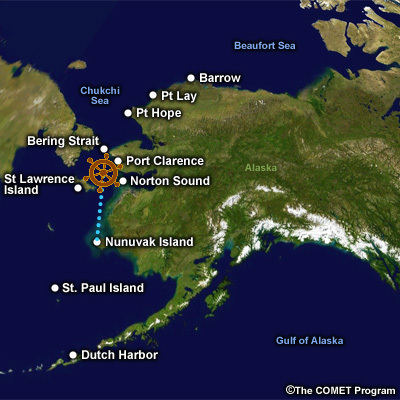Aug 06, 2000Forecast Considerations for 07 August

The next leg of the trip takes the ship abreast Norton Sound and east of St. Lawrence Island. The Captain is deciding whether to continue on into the Bering Strait and the Chukchi Sea, pull into the lee of Saint Lawrence Island, or proceed to the excellent deep water harbor at Port Clarence. The Captain asks for another brief with options. coast.
So, I look at the weather for passage through the Bering Strait.
Funneling of wind through the strait results when there is a significant pressure gradient. I've experienced gap winds before going in and out of Puget Sound with high pressure over Eastern Washington and a Pacific storm approaching the coast.
To further compound the issue, the prevailing current is from south to north. If higher pressure builds on the north side of the Bering Strait, then swell from the north could oppose a current from the south, resulting in a higher sea state and steeper waves pounding the ship and slowing it down. This happens all the time off the Virginia Capes area of the East Coast where swell from a Nor'Easter runs southwest into the northeast-flowing Gulf Stream. It's one of the so-called North Wall Effects that sailors in Norfolk, VA complain about.
To further compound the issue, the prevailing current is from south to north. If higher pressure builds on the north side of the Bering Strait, then swell from the north could oppose a current from the south, resulting in a higher sea state and steeper waves pounding the ship and slowing it down. This happens all the time off the Virginia Capes area of the East Coast where swell from a Nor'Easter runs southwest into the northeast-flowing Gulf Stream. It's one of the so-called North Wall Effects that sailors in Norfolk, VA complain about.
Flow Interaction with Topography in the Arctic
To learn more, see COMET module
North Wall Effects on Winds and Waves
Flow Interaction with Topography in the Arctic
To learn more, see COMET module
North Wall Effects on Winds and Waves